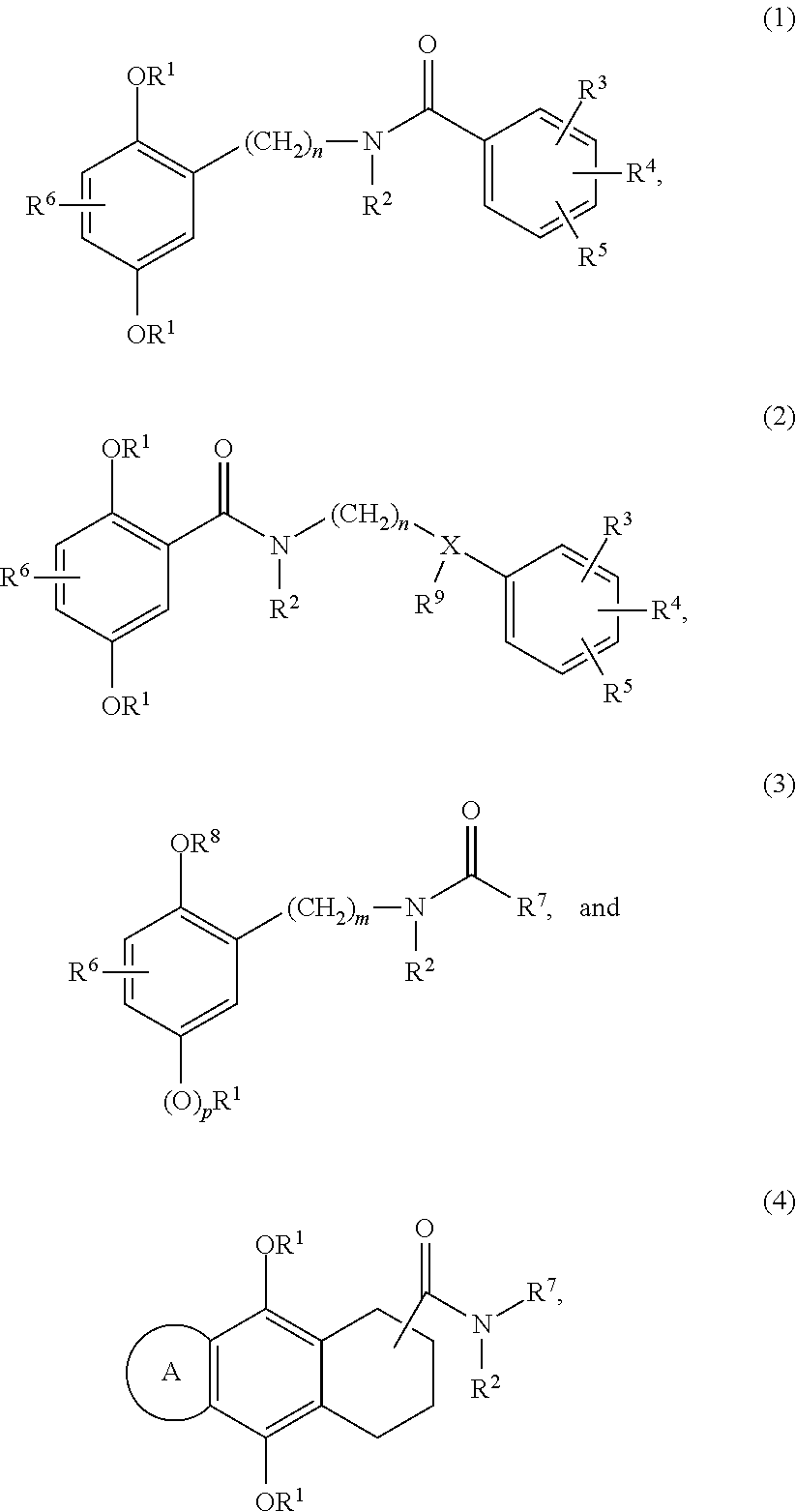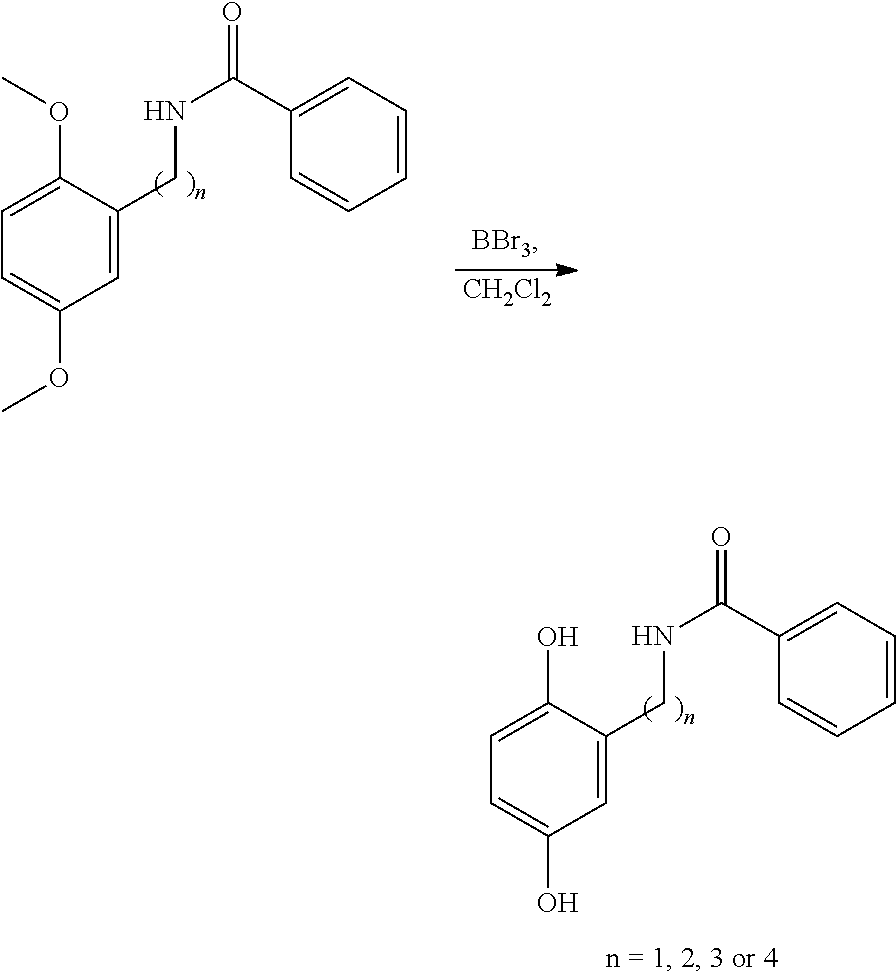Composition for treatment of pathogens that are resistant to tetracyclines
a technology of tetracycline resistance and compound, which is applied in the field of compound and pharmaceutical composition, can solve the problems of increasing the number of untreatable strains, limiting the treatment of these pathogens, and increasing the number of drug resistant isolates, so as to prevent the transcriptional activation of tet resistance genes and achieve the effect of potentiating the activity
- Summary
- Abstract
- Description
- Claims
- Application Information
AI Technical Summary
Benefits of technology
Problems solved by technology
Method used
Image
Examples
examples
Liquid Chromatography (LC)
[0150]HPLC Column: Reverse Phase, Uptisphere Strategy C18-2, 5 μm 4.6×250 mm;
[0151]Wavelength: 254 nm or 280 nm; HPLC Apparatus Type: Agilent 1100 Series, DAD detector; MS Apparatus Type: Agilent MSD Trap XCT positive / negative mode switching, Ionization mode APCI.
[0152]LCMS System 01 (LCMS 01): Gradient 01
[0153]Solvent A: Water / methanol (95:5), 0.2% acetic acid; Solvent B: Methanol / water (95;5), 0.2% acetic acid;
Time (min)Flow (mL / min)% A% B0.001100010.001010018.001010018.101100020.0011000
examples 1-3 , 5-11 and 39-42
Examples 1-3, 5-11 and 39-42, Compounds of Formula (1)
General Synthesis Scheme for Compounds of Formula (1)
Step 1
[0154]
[0155]To a magnetically stirred solution of 2,5-dimethoxybenzylamine (n=1) (500 mg, 2.99 mmol, 0.45 mL) in CH2Cl2 (4 mL) at room temperature was added drop wise benzoyl chloride (504 mg, 3.59 mmol, 0.42 mL) followed by ethyldiisopropylamine (0.5 mL). The mixture was stirred for a further 22.5 hours before being concentrated in vacuo. The residue was purified over silica gel with 0-50% ethyl acetate in cyclohexane to yield N-[(2,5-dimethoxyphenyl)methyl]benzamide (n=1) (728 mg, 2.68 mmol) in 90% yield.
Step 2
[0156]
[0157]To a magnetically stirred solution of N-[(2,5-dimethoxyphenyl)methyl]benzamide (n=1) (563 mg, 2.08 mmol) in CH2Cl2 at room temperature was added drop wise boron tribromide (2.08 g, 8.30 mmol, 0.80 mL) and stirred for a further 21 hours before being quenched cautiously with MeOH (4 mL). The reaction mixture was then concentrated in vacuo and further por...
examples 12 , 13 and 17
Examples 12, 13 and 17, Compound of Formula (3)
General Synthesis Scheme
Step 1
[0162]
[0163]To a magnetically stirred solution of 3-phenylphenol (457 mg, 2.69 mmol) in tetrahydrofuran (30 mL) at room temperature was added magnesium chloride (511 mg, 5.37 mmol), triethylamine (543 mg, 5.37 mmol, 0.75 mL), and then paraformaldehyde (242 mg, 8.06 mmol). The reaction mixture was heated to 66° C. and stirred for 4 days, cooled to room temperature and the solvents removed in vacuo. The residue was partitioned between H2O (50 mL) and CH2Cl2 (50 mL), and the layers shaken and separated. The aqueous layer was extracted with CH2Cl2 (2×50 mL), and the combined organic extracts were washed with brine (50 mL), dried (Na2SO4) and concentrated in vacuo. The residue was purified over silica gel with 0-30% ethyl acetate in cyclohexane to yield an approximate 1:1 inseparable mixture of 2-hydroxy-4-phenylbenzaldehyde and 2-hydroxy-6-phenylbenzaldehyde (300 mg, 1.51 mmol) in 56% yield.
Step 2
[0164]
[0165]A ...
PUM
| Property | Measurement | Unit |
|---|---|---|
| temperature | aaaaa | aaaaa |
| temperature | aaaaa | aaaaa |
| temperature | aaaaa | aaaaa |
Abstract
Description
Claims
Application Information
 Login to View More
Login to View More - R&D
- Intellectual Property
- Life Sciences
- Materials
- Tech Scout
- Unparalleled Data Quality
- Higher Quality Content
- 60% Fewer Hallucinations
Browse by: Latest US Patents, China's latest patents, Technical Efficacy Thesaurus, Application Domain, Technology Topic, Popular Technical Reports.
© 2025 PatSnap. All rights reserved.Legal|Privacy policy|Modern Slavery Act Transparency Statement|Sitemap|About US| Contact US: help@patsnap.com



